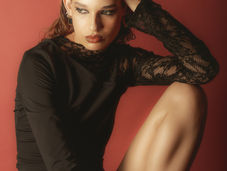'Mary Quant' Review - V&A
- Monica Mao
- Jun 14, 2019
- 3 min read
6th April 2019 - 16th February 2020
Standard Ticket - £12 Students: £10
Mary Quant is undeniably one of the most high-profile British fashion designers of the 1960s. Although Quant was not the first one to raise hemlines, she popularised miniskirts epitomising a provocative style different to the norm. The Victoria and Albert Museum celebrates her remarkable contribution to liberating womenswear with the first international retrospective exhibition on Quant in nearly fifty years. This exhibition highlights the vitality of Quant’s designs and the international appeal of her brand.
Featuring Quant’s work in chronological order, the enticing dual-levelled fashion gallery displays over 200 garments, accessories, cosmetics, photographs and archive footages during her design career from 1955 to 1975. What is special about this exhibition are the thirty-five items borrowed from the public by its curators Jenny Lister and Stephanie Wood. It is these objects alongside personal testimonies of the women who responded to the #WeWantQuant campaign that present the power of this creative designer as a fashion icon of a new feminism in that formative period.

Photo: © Victoria and Albert Museum, London
It opens with miniskirts which, for most people, are synonymous with Quant’s name; they are laid out like window displays in Quant’s first boutique, Bazaar, which was on the King’s Road and afterwards became the epicentre of fashion centres in London. Under the influence of the Chelsea Set—a group of radical artists and socialites—Quant created a bold look on women's style characterising the 'Swinging Sixties' scene. Quant’s liberating miniskirts are central to her designs and perfectly complemented with her brightly-coloured tights and stockings, representing the innovative identity of post-war Britain. Additionally, many of Quant’s garments embody a sporty silhouette and masculine tailoring, symbolising a London street style revolution.
‘The whole point of fashion is to make fashionable clothes available to everyone’, declared Mary Quant in 1966. During an age in which Parisian haute couture dominated in fashion industry, such as Christian Dior’s ‘New Look’, Quant was committed to defining the youthfully vivacious look of the 1960s. She did the by rebelling against waisted corsetry and creating loose shift dresses and dropped-waist pinafores, as an alternative to enable free movement and self-expression. In 1963, by expanding her company, the Ginger Group, into the UK mass market with a more affordable diffusion line, her outfits attracted a wider clientele from all backgrounds and ages.

Photo: © Victoria and Albert Museum, London
Entering the second part of the exhibition upstairs, visitors are shown Mary Quant’s global influence. Quant’s brand has achieved unprecedented reach around the world with a wide range of products including cosmetics and home furnishings. One stand out part of this exhibition is Quant’s makeup line which was famous for its high-visibility packaging and is still popular amongst the public today. Quant expanded her market with the Daisy fashion doll in 1973, offering customers an opportunity to buy miniature versions of her outfits.
A revolutionary approach to unusual fabrics was another move she is well known for. After experimenting with new materials, the application of polyvinyl chloride (PVC) to fashion was pioneered by Quant and some examples of the ground-breaking ‘Wet Collection’ she launched in 1963 are displayed in this exhibition, some being plastic-moulded boots in quirky colours. Quant excelled at inventing distinctive designs to satisfy the younger generation’s hunger for fresh and unique looks.

Photo: © Victoria and Albert Museum, London
The magic of Mary Quant is perhaps her avant-garde fashion design vision: she dares to challenge conventional stereotypes and subverts established gender norms in the realm of fashion. The exhibition in the V&A discovers the significance of Mary Quant as a fashion trailblazer in the 1960s and recognises her enduring influence on the British High Street.
Edited by Evangeline Stanford, Digital Editor
























Comments